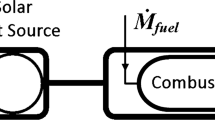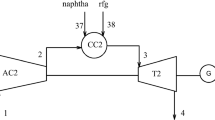Abstract
Adding renewable energy sources to an existing power system is one way to increase the power output of that system and make it more efficient. This study investigates the thermodynamics of a triple power cycle that combines Gas Turbine (GT), Rankine cycle (RC), and Kalina cycle (KC) with Solar and Biomass assistance. For top** cycle, an existing Gas Turbine cycle was used, whereas the intermediate cycle in the notion of research is the Rankine cycle and the bottoming cycle is Kalina cycle in the concept of study. Parametric optimisation was used to determine the best efficient system operating parameters as well as the likely maximum overall performances for each of the single and multi-systems. In the literature, the collector efficiency of the solar field is found to be 53.17%, however, in the current investigation, it is 53.35%. Similar to how the thermal efficiency of the solar field in the literature is discovered to be 36.12% while it is 36.74% in the current study, the current value is supported by the tiny variation in the current value. The power developed by Gas Turbine post the eclectic analysis was evaluated as 40.71 MW, it was quantified as 14.32 MW and 5.982 MW using Rankine and Kalina cycles, respectively. The energy and exergy efficiencies were computed as 40.53% and 41.38%. This research evinces that the modules of PTC and biogas considered in this study contribute to enhancing the power of a triple power cycle.














Similar content being viewed by others
Abbreviations
- Aa :
-
Collector aperture
- Cr :
-
Concentration ratio
- D:
-
Diameter
- F:
-
Objective function
- GT:
-
Gas turbine
- Gb :
-
Beam radiation of solar, W/m2
- hca :
-
Convection coefficient between cover and atmosphere, W/m2 K
- L:
-
Length of tube
- \(\dot{m}\) :
-
Mass flow rate
- M:
-
Amount of air pollutions
- KC:
-
Kalina cycle
- Np :
-
Parallel series of modules in the collector
- NPTC :
-
Sum of all collector’s modules
- Ns :
-
Modules in series in PTC
- P:
-
Pressure
- PTC:
-
Parabolic trough collector
- Q:
-
Heat transfer, kJ/kg
- RC:
-
Rankine cycle
- Rc :
-
Universal gas constant
- rp :
-
Pressure ratio
- T:
-
Temperature
- Tsun :
-
Sun temperature
- TIT:
-
Turbine inlet temperature
- VAS:
-
Vapour absorption system
- W:
-
Breadth in mm
- Ɛ:
-
Emittance of solar surface
- η:
-
Efficiency of cycle
- µα :
-
Chemically correct A:F ratio
- \(\Delta P\) :
-
Drop of pressure in kPa
- Ƴ:
-
Capacity ratio of heat
- \({\xi }_{fuel}\) :
-
Exergy factor
- µ:
-
Dynamic viscosity, Pa s
- \(\epsilon\) :
-
Effectiveness
- a:
-
Air
- am:
-
Atmospheric
- b:
-
Combustor
- ci :
-
Inner cover
- co :
-
Outer cover
- cond:
-
Condenser
- dest:
-
Destroyed
- gen:
-
Generator
- isen, C:
-
Compressor isentropic
- isen, T:
-
Turbine isentropic
- m:
-
Mechanical
- opt:
-
Optimum
- ri, ro :
-
Inner receiver, outer receiver
- u:
-
Useful
- w:
-
Water
References
Agrawal Y, Bhagoria JL, Gautam A, Sharma A, Yadav AS, Alam T, Kumar R, Goga G, Chakroborty S, Kumar R (2023) Investigation of thermal performance of a ribbed solar air heater for sustainable built environment. Sustain Energy Technol Assess 1(57):103288
Ahmad S, Parvez M, Khan TA, Siddiqui SA, Khan O (2022) Performance comparison of solar-powered cogeneration and trigeneration systems via energy and exergy analyses. Int J Exergy 39(4):395–409
Ahn JH, Kim TS (2020) Effect of oxygen supply method on the performance of a micro gas turbine-based triple combined cycle with oxy-combustion carbon capture. Energy 211:119010
Akram W, Parvez M, Khan O (2023) Parametric analysis of solar-assisted trigeneration system based on. J Thermal Eng 9(3):764–775
Alam MA, Kumar R, Yadav AS, Arya RK, Singh VP. Recent developments trends in HVAC (heating, ventilation, and air-conditioning) systems: A comprehensive review. Materials Today: Proceedings. 2023 Feb 8.
Anvari S, Taghavifar H, Parvishi A (2017) Thermo- economical consideration of Regenerative organic Rankine cycle coupling with the absorption chiller systems incorporated in the trigeneration system. Energy Convers Manage 148:317–329
Bellos E, Tzivanidis C (2017) A detailed exergetic analysis of parabolic trough collectors. Energy Convers Manage 149:275–292
Bellos E, Tzivanidis C, Antonopoulos KA (2017) Parametric analysis and optimization of a solar assisted gas turbine. Energy Convers Manage 139:151–165
Cao Y et al (2021) A novel hybrid biomass-solar driven triple combined power cycle integrated with hydrogen production: Multi-objective optimization based on power cost and CO2 emission. Energy Convers Manage 234:113910
Cao Y et al (2021) Proposal and thermo-economic optimization of using LNG cold exergy for compressor inlet cooling in an integrated biomass fueled triple combined power cycle. Int J Hydrogen Energy 46:15351–15366
Dominkovic D, Cosic B, Bacˇelic´ Medic Z, Duic N (2015) A hybrid optimization model of biomass trigeneration system combined with pit thermal energy storage. Energy Conv Manag 104: 90–99
Elavarasan RM (2019) The motivation for renewable energy and its comparison with other energy sources: a review. Euro J Sustain Dev Res 3(1):1–19
Gogoi TK, Hazarika P (2020) Comparative assessment of four novel solar based triple effect absorption refrigeration systems integrated with organic Rankine and Kalina cycles. Energy Convers Manage 226:113561
Hafez AZ, AS, KE-M, II (2016) Solar parabolic dish Stirling engine system design, simulation, and thermal analysis. Energy Conversion Manag 60–75.
Howari H et al (2023) Multi-objective optimization for ranking waste biomass materials based on performance and emission parameters in a pyrolysis process—an AHP–TOPSIS approach. Sustainability 15(4):3690
Howari H, Parvez M, Khan O, Alhodaib A, Mallah A, Yahya Z (2023) Multi-objective optimization for ranking waste biomass materials based on performance and emission parameters in a pyrolysis process—an AHP–TOPSIS approach. Sustainability 15(4):3690
Karellas S, Braimakis K (2015) Energy–exergy analysis and economic investigation of a cogeneration and trigeneration ORC–VCC hybrid system utilizing biomass fuel and solar power. Energy Convers Manage 107:103–113
Khan F, Karimi MN, Khan O (2023) Exploring the scalability and commercial viability of biosynthesized nanoparticles for cooling panels with the help of Artificial Intelligence and solar energy systems. Green Technol Sustain 1(3):100036
Kumar RR, Sharma S, Saxena R, Singhal PK, Kumar R, Goga G, Chakroborty S, Singh M, Agrawal Y, Allamraju KV, Pagey VS. Computational analysis and evaluation of thermal comfort environment of a space by reducing the inside air temperature. Materials Today: Proceedings. 2023 Jan 28.
Lahoud C, Asmar JA, Brouche M (2018) Review of cogeneration and trigeneration systems. African J Eng Res 6(3):39–54
Li H et al (2016) Exergy and environmental assessments of a novel trigeneration system taking biomass and solar energy as co-feeds. Appl Therm Eng 104:697–706
Musharavati F, Khanmohammadi S, Pakseresht A, Khanmohammadi S (2021) Waste heat recovery in an intercooled gas turbine system: Exergo-economic analysis, triple objective optimization, and optimum state selection. J Clean Prod 123428: Volume 279.
Nasim MA, Khan O, Parvez M, Chouhan PS (2023) Maximizing biodiesel production: an intelligent software-driven optimization of ultrasonic reactor operating variables. Bioresource Technol Rep 20:101474
Nasim MAG, Khan O, Parvez M, Chouhan PS (2023) Maximizing biodiesel production: an intelligent software-driven optimization of ultrasonic reactor operating variables. Bioresource Technol Rep 22:101474
Nasim MA, Khan O, Parvez M, Bhatt BK (2023) Optimizing ultrasonic reactor operating variables using intelligent soft computing models for increased biodiesel production. Green Technol Sustain 1(3):100033
Parvez M et al (2023) An assessment of solar driven combined cooling, heating, and electric power generation system: using energy, exergy, and CO2 mitigation approach. J Modern Green Energy 2(5).
Parvez M, Lal S, Khan OH, Siddiqui SA. An assessment of solar driven combined cooling, heating, and electric power generation system: using energy, exergy, and CO2 mitigation approach. J Mod Green Energy. 2023;2(5).
Parvez M, Khan O (2020) Parametric simulation of biomass integrated gasification combined cycle (BIGCC) power plant using three different biomass materials. Biomass Conv Biorefinery 10:803–812
Patel AK, Rajput SP, Kumar R, Sharma A, Saxena KK, Agrawal MK, Kadhim IK (2023) Experimental and numerical investigation of metal oxide base nano particles for VCRS test rig. Int J Interactive Design Manuf (IJIDeM) 1:1–8
Peng S, Hong H, ** H, Wang Z (2012) An integrated solar thermal power system using intercooled gas turbine and Kalina cycle. Energy 44:732–740
Roy D, Samanta S, Ghosh S (2019) Techno-economic and environmental analyses of a biomass based system employing solid oxide fuel cell, externally fired gas turbine and organic Rankine cycle.. s.l.:Journal of Cleaner Production.
Sachdeva J, Singh O (2019) Thermodynamic analysis of solar powered triple combined brayton, rankine and organic Rankine Cycle for carbon free power. Renew Energy 139:765–780
Sanjay & Prasad, BN (2013) Energy and exergy analysis of intercooled combustion-turbine based combined cycle power plant. Energy, 59: 277-284
Schwarzbozl P et al (2006) Solar gas turbine systems: design, cost and perspectives. Sol Energy 80:1231–1240
Sheu EJ, Mitsos A (2012) A review of hybrid solar-fossil fuel power generation systems and performance metrics. J SolEnergy Eng 134:1–17
Singh OK, Kaushik S (2013) Thermoeconomic evaluation and optimization of a Brayton–Rankine–Kalina combined triple power cycle. Energy Convers Manage 71:32–42
Singh OK, Kaushik SC (2013) Thermoeconomic evaluation and optimization of a Brayton–Rankine–Kalina combined triple power cycle. Energy Convers Manage 1(71):32–42
Spelling J, Laumert B, Fransson T (2012) Optimal gas-turbine design for hybrid solar gas-turbine power plant operation. J Eng Gas-Turbines Power 134(9):1–9
Srinivas T, Reddy B (2014) Hybrid solar–biomass power plant without energy storage. Case Stud Thermal Eng 2:75–81
Zahedi AR, Mirnezami SA (2020) Experimental analysis of biomass to biodiesel conversion using a novel renewable combined cycle system. Renew Energy 162:1177–1194
Zellner S, Burgtorf J, Kraft-Schäfer D (2016) Co and Trigeneration Technologist and their applications. Germany: Deutsche Gesellschaft für Internationale Zusammenarbeit (GIZ) GmbH.
Zhao C, Zheng S, Zhang J, Zhang Y (2017) Exergy and economic analysis of organic rankine cycle hybrid system utilizing biogas and solar energy in rural area of China. Int J Green Energy 14(14):1–20
Author information
Authors and Affiliations
Contributions
The contribution of all the authors is equal. 1-3The concept, idea, framework 4-7 editing and critical analysis of the results 1-7 The literature survey and drafting and writing were done by all authors.
Corresponding author
Ethics declarations
Competing interests
The authors declare no competing interests.
Additional information
Publisher's Note
Springer Nature remains neutral with regard to jurisdictional claims in published maps and institutional affiliations.
Rights and permissions
Springer Nature or its licensor (e.g. a society or other partner) holds exclusive rights to this article under a publishing agreement with the author(s) or other rightsholder(s); author self-archiving of the accepted manuscript version of this article is solely governed by the terms of such publishing agreement and applicable law.
About this article
Cite this article
Kumar, M., Arora, A., Pandey, S. et al. Thermodynamic performance analysis of solar-biomass based gas turbine- Rankine–Kalina combined triple power cycle. Multiscale and Multidiscip. Model. Exp. and Des. 7, 673–688 (2024). https://doi.org/10.1007/s41939-023-00235-z
Received:
Accepted:
Published:
Issue Date:
DOI: https://doi.org/10.1007/s41939-023-00235-z




